Merging of the Fukushima Health Management Survey With the National and Local Cancer Registry to Refine the Detection of Thyroid Cancer Cases After the 2011 Fukushima Daiichi Nuclear Power Plant Accident
Abstract
Background
After the Fukushima Daiichi Nuclear Power Plant accident in 2011, the Fukushima Health Management Survey (FHMS) was implemented in Fukushima Prefecture to promote long-term health care. The FHMS included thyroid ultrasound examination (TUE) for individuals aged ≤ 18 years, including fetuses at the time of the accident. However, the FHMS may not have captured all cases of thyroid cancer because it only followed up with examinees. To address this gap, we aimed to merge individual-level information from the FHMS with national and local cancer registries (CRs) to determine the limitations of the FHMS and CRs in capturing thyroid cancer cases.
Methods
The FHMS-eligible residents' information was supplemented by merging and cross-validating the FHMS and CR data using the Fukushima Prefectural Cancer Registry (FPCR), 2008–2015, and the National Cancer Registry (NCR), 2016–2018. For analysis, registered cases were classified into three groups: registered in both the CR and FHMS, or only in the CRs, or only in the FHMS. The characteristics of each case were evaluated in each database.
Results
In the FHMS, 212 thyroid cancer cases were identified through 2018, with another 42 cases identified in the CRs. Of the 176 thyroid cancer cases registered until 2015, 28 (15.9%) were identified in the FHMS only and 13 (7.4%) in the FPCR only. Of the 78 additional cases identified since 2016, 29 (37.2%) were identified in the NCR only and 6 (7.7%) in the FHMS only. This indicates that the NCR captured the cases more efficiently than the FPCR.
Conclusion
Merging data from the FHMS and CRs at the individual level is necessary to capture thyroid cancer cases more accurately after the 2011 nuclear accident.


 求助内容:
求助内容: 应助结果提醒方式:
应助结果提醒方式:


